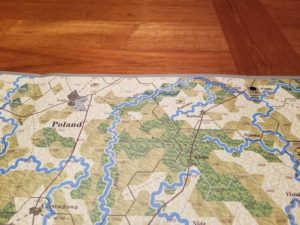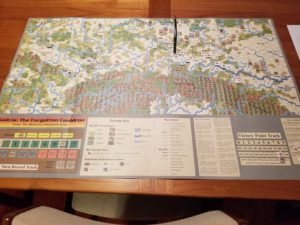Since World War One is no longer trending, the contrarian in me says it’s safe to start playing this operational series.
I’ve purchased several of the titles, and have been waiting for some time to engage with, get comfortable with the rules, and play a bunch of them. What initially attracted me to the series was the number of East Front games (now consolidated into a single package) and its coverage of the Ottomans. I also picked up the Italian Front game (really cheap on E-Bay) for when I feel like just bogging down in attritional nihilism.
Each game comes with a copy of the basic rules, along with scenario(s) specific rules
At first glance, this appears to be a typical hex and counter operational series. Railroads enhance movement, headquarters effect supply, supply and supply lines effect combat, units have zones of control, fortresses and trenches aide the defender, and artillery units have special rules. Turns are monthly, with each month starting with a trench completion and initiation phase, and then four phases per side. Both players have reinforcement arrival, movement, combat, and replacement/recombination phases. Reinforcement schedules are shown along with the initial orders of battle.
But, there are two major and one minor differences from other operational games.
The first involves terrain. Each hex side can have multiple types of terrain. The defender is allowed to choose the terrain through which he is attacked. For example, if the attack hex side has both clear and rough terrain, the defender can choose the rough terrain, and enjoy the appropriate combat modifier. Terrain also effects movement, in that the player can “weave” his way through clear or lower cost hex sides. To me, this non-linear “weaving” is like following a valley that twists between hillsides.

The second difference involves combat. The attacker uses a standard means of calculating attack strength; adding attack points and modifying for (defender chosen) terrain. A single die is rolled and cross referenced with the Combat Results Table (CRT) Before any losses are taken, the defender can choose to retreat one hex and reduce his losses by 1/3. If not, the defender counterattacks. The defender totals his strength points, multiplies them by three (artillery only doubled), and makes the appropriate adjust for terrain (that he initially picked). The effects are again cross referenced on the CRT. The triple strength counterattacks can really give the attacker a bloody nose.
The minor difference is how replacements are handled. Replacement points are received, but must be formed into “battalions of march” and either marched or railroaded to a headquarters for integration into a co-located unit. Recombination is simply combining two co-located below strength units into one.
I’ve set up Galicia: The Forgotten Cauldron twice now. Both times on surfaces that had to be cleared to accommodate guests. This time it’s going up in “my” room and it will be completed. It is also to enjoyable and educational to follow the narrative of both Collision of Empires and Written In Blood on the maps. I was able to pick up both titles on Kindle for $1.99 each last Fall. The only problem is that some of the towns in the narrative are not represented in the game battle maps.

I really like what Designer David Schroeder has done. He still maintains a website, but the series is now distributed by Decision Games.